中医英语翻译理论与实践
英语翻译理论与实践课程教学方法研究
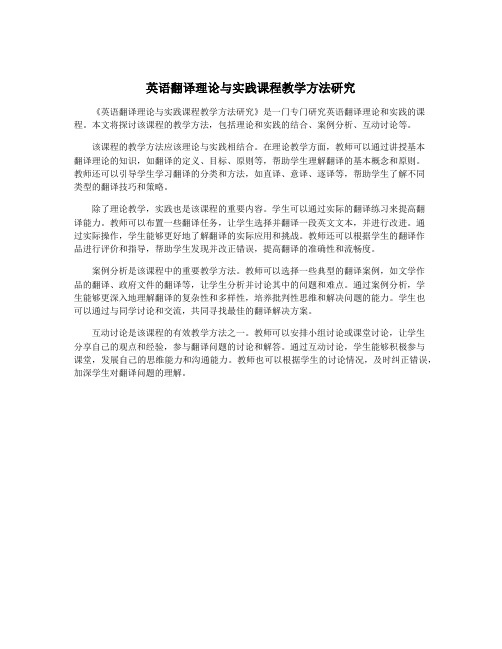
英语翻译理论与实践课程教学方法研究
《英语翻译理论与实践课程教学方法研究》是一门专门研究英语翻译理论和实践的课程。
本文将探讨该课程的教学方法,包括理论和实践的结合、案例分析、互动讨论等。
该课程的教学方法应该理论与实践相结合。
在理论教学方面,教师可以通过讲授基本
翻译理论的知识,如翻译的定义、目标、原则等,帮助学生理解翻译的基本概念和原则。
教师还可以引导学生学习翻译的分类和方法,如直译、意译、逐译等,帮助学生了解不同
类型的翻译技巧和策略。
除了理论教学,实践也是该课程的重要内容。
学生可以通过实际的翻译练习来提高翻
译能力。
教师可以布置一些翻译任务,让学生选择并翻译一段英文文本,并进行改进。
通
过实际操作,学生能够更好地了解翻译的实际应用和挑战。
教师还可以根据学生的翻译作
品进行评价和指导,帮助学生发现并改正错误,提高翻译的准确性和流畅度。
案例分析是该课程中的重要教学方法。
教师可以选择一些典型的翻译案例,如文学作
品的翻译、政府文件的翻译等,让学生分析并讨论其中的问题和难点。
通过案例分析,学
生能够更深入地理解翻译的复杂性和多样性,培养批判性思维和解决问题的能力。
学生也
可以通过与同学讨论和交流,共同寻找最佳的翻译解决方案。
互动讨论是该课程的有效教学方法之一。
教师可以安排小组讨论或课堂讨论,让学生
分享自己的观点和经验,参与翻译问题的讨论和解答。
通过互动讨论,学生能够积极参与
课堂,发展自己的思维能力和沟通能力。
教师也可以根据学生的讨论情况,及时纠正错误,加深学生对翻译问题的理解。
中医的专业术语英文翻译

中医的专业术语英文翻译大家在写中医论文时候常常遇到一些不容易翻译的词汇,yjbys 网整理了中医的专业术语英文翻译,方便大家写作。
快来点赞吧。
中国医药学:traditional Chinese medicine中医基础理论:basic theory of traditional Chinese medicine临床经验:clinical experience辨证论治:treatment based on syndrome differentiation本草:materia medica //medicinal herbs中药Chinese herbs四气五味:four properties and five tastes针灸acupuncture and moxibustion各家学说theories of different schools汗法: diaphoresis /diaphoretic therapy下法:purgative therapy吐法:emetic therapy补土派:school of invigorating the earth病因学说:theory of etiology养生:health-cultivation医疗实践medical practice治疗原则:therapeutic principles寒凉药物:herbs of cold and cool nature滋阴降火:nourishing yin to lower fire瘀血致病:disease caused by blood stasis先天之精:congenital essence气的运动变化:movement and changes of qi。
中医的专业术语英文翻译
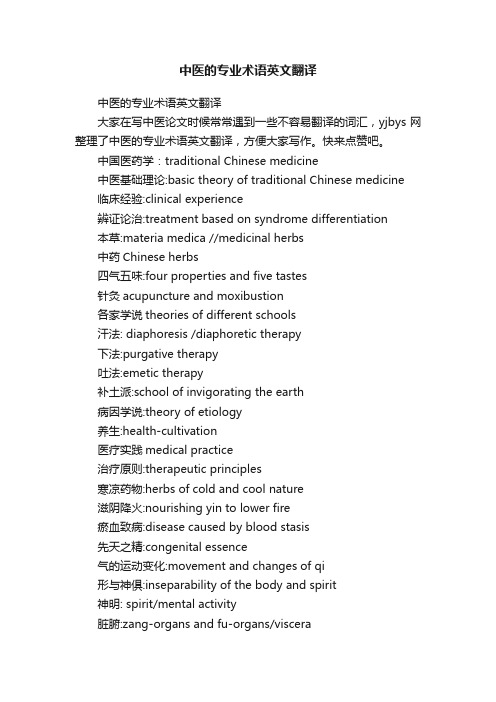
中医的专业术语英文翻译中医的专业术语英文翻译大家在写中医论文时候常常遇到一些不容易翻译的词汇,yjbys网整理了中医的专业术语英文翻译,方便大家写作。
快来点赞吧。
中国医药学:traditional Chinese medicine中医基础理论:basic theory of traditional Chinese medicine临床经验:clinical experience辨证论治:treatment based on syndrome differentiation本草:materia medica //medicinal herbs中药Chinese herbs四气五味:four properties and five tastes针灸acupuncture and moxibustion各家学说theories of different schools汗法: diaphoresis /diaphoretic therapy下法:purgative therapy吐法:emetic therapy补土派:school of invigorating the earth病因学说:theory of etiology养生:health-cultivation医疗实践medical practice治疗原则:therapeutic principles寒凉药物:herbs of cold and cool nature滋阴降火:nourishing yin to lower fire瘀血致病:disease caused by blood stasis先天之精:congenital essence气的运动变化:movement and changes of qi形与神俱:inseparability of the body and spirit神明: spirit/mental activity脏腑:zang-organs and fu-organs/viscera功能活动:functional activities形神统一:unity of the body and spirit阴阳失调:imbalance of yin and yang正邪相争:struggle between healthy qi and pathogenic factors 治未病prevention of disease调养 to cultivate health正气 healthy qi病邪 pathogenic factor疾病的防治 prevention and treatment of disease整体观念 concept of holism五脏five zang-organs六腑six fu-organs经络系统system of meridians and collaterals形神统一unity of the body and spirit有机整体organic wholeness表里关系exterior and interior relation开窍opening into生长化收藏five element function脉象pulse conditions正邪关系the states of pathogenic factors and healthy qi自然现象natural phenomena哲学概念philosophical concept对立统一unity and opposites相互消长mutual waning and waxing阴阳属性nature of yin and yang相互转化mutual transformation相互联系interrelation相互制约mutual restraint动态平衡dynamic balance阴平阳秘yin and yang in equilibrium阳消阴长 yang waning and yin waxing阴胜则阳病predominance of yin leading to disorder of yang 阳胜则热 predominance of yang generating heat寒极生热 extreme cold generating heat热极生寒extreme heat generating cold相反相成 opposite and supplementary to each other生理功能physiological functions病理变化pathological changes临床诊断clinical diagnosis有机整体organic wholeness/entirety正邪斗争struggle between healthy qi and pathogenic factors 绝对偏盛absolute predominance阳虚则寒yang deficiency leading to cold阳损及阴consumption of yang involving yin阴液不足insufficiency of yin-fluid病机pathogenesis五行学说theory of five elements运动变化motion and variation条达舒畅free development相生相克mutual generation and restriction生我我生to be generated and to generate克我我克to be restricted and to restrict生中有制restriction within generation克中有生generation within restriction木曰曲直Wood is characterized by growing freely and peripherally火曰炎上Fire is characterized by flaming up土曰稼穑Earth is characterized by cultivation and reaping金曰从革Metal is characterized by change水曰润下Water is characterized by moistening anddownward flowing方位配五行correspondence of the directions to the five elements相乘相侮over-restriction and reverse restriction土乘木The wood over-restrains the earth土虚木乘 Earth deficiency leading to over-restriction by wood 金虚木侮metal deficiency leading to counter-restriction by wood生克制化interrelationship between generation and restriction制则生化restriction ensuring generation传变transmission of disease母病及子disease of the mother-organ affecting the child-organ子病犯母disease of the child-organ affecting the mother-organ肝肾精血不足insufficiency of kidney and liver essence and blood肝阳上亢hyperactivity of liver yang藏象学说 theory of visceral manifestations五脏六腑 five zang-organs and six fu-organs奇恒之府 extraordinary fu-organs水谷精微 cereal nutrients传化水谷 transmissions and transformation of food贮藏精气 storage of essence表里关系 interior and exterior relationship治疗效应 curative effect临床实践 clinical practice藏而不泻 storage without excretion心肝血虚deficiency of heart and liver blood心肝火旺exuberance of heart and liver fire心火亢盛exuberance of heart fire滋肾养肝nourishing the kidney and liver肝阴不足insufficiency of the liver yin温肾健脾warming the kidney and strengthening the spleen 肾阳式微declination of kidney yang脾阳不振inactivation of spleen yang肝旺脾虚hyperactivity of the liver and weakness of the spleen 脾胃虚弱weakness of the spleen and stomach平肝和胃soothing the liver and harmonizing the stomach水湿停聚retention of water-dampness肾阴不足insufficiency of kidney yin心肾不交disharmony between the heart and kidney水火不济discordance between water and fire阴阳俱损simultaneous consumption of yin and yang阴阳两虚simultaneous deficiency of both yin and yang损其有余reducing excess补其不足supplementing insufficiency阴中求阳obtaining yang from yin虚寒证deficiency-cold syndrome扶阳益火strengthening yang to increasing fire祛风散寒eliminating wind to dispersing cold消导积滞promoting digestion and removing food retention 潜阳息风suppressing yang to quench wind阴阳的互根互用interdependence of yin and yang相互依存interdependence。
中医药名词英文翻译01(学科相关词汇)
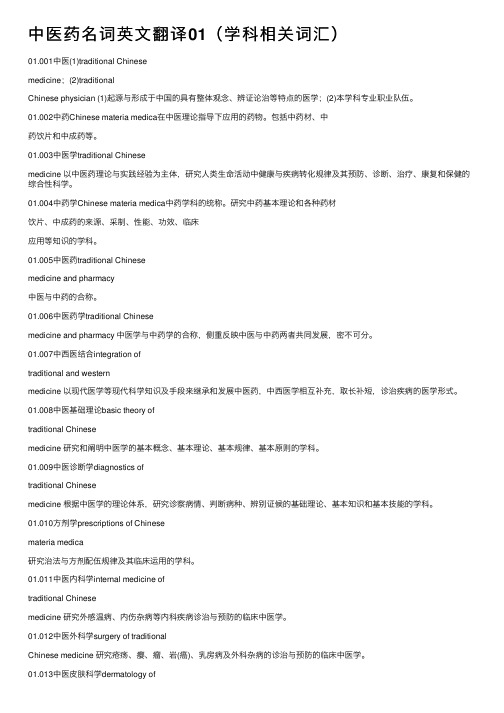
中医药名词英⽂翻译01(学科相关词汇)01.001中医(1)traditional Chinesemedicine;(2)traditionalChinese physician (1)起源与形成于中国的具有整体观念、辨证论治等特点的医学;(2)本学科专业职业队伍。
01.002中药Chinese materia medica在中医理论指导下应⽤的药物。
包括中药材、中药饮⽚和中成药等。
01.003中医学traditional Chinesemedicine 以中医药理论与实践经验为主体,研究⼈类⽣命活动中健康与疾病转化规律及其预防、诊断、治疗、康复和保健的综合性科学。
01.004中药学Chinese materia medica中药学科的统称。
研究中药基本理论和各种药材饮⽚、中成药的来源、采制、性能、功效、临床应⽤等知识的学科。
01.005中医药traditional Chinesemedicine and pharmacy中医与中药的合称。
01.006中医药学traditional Chinesemedicine and pharmacy 中医学与中药学的合称,侧重反映中医与中药两者共同发展,密不可分。
01.007中西医结合integration oftraditional and westernmedicine 以现代医学等现代科学知识及⼿段来继承和发展中医药,中西医学相互补充,取长补短,诊治疾病的医学形式。
01.008中医基础理论basic theory oftraditional Chinesemedicine 研究和阐明中医学的基本概念、基本理论、基本规律、基本原则的学科。
01.009中医诊断学diagnostics oftraditional Chinesemedicine 根据中医学的理论体系,研究诊察病情、判断病种、辨别证候的基础理论、基本知识和基本技能的学科。
01.010⽅剂学prescriptions of Chinesemateria medica研究治法与⽅剂配伍规律及其临床运⽤的学科。
中医术语汉译英的基本方法专家讲座
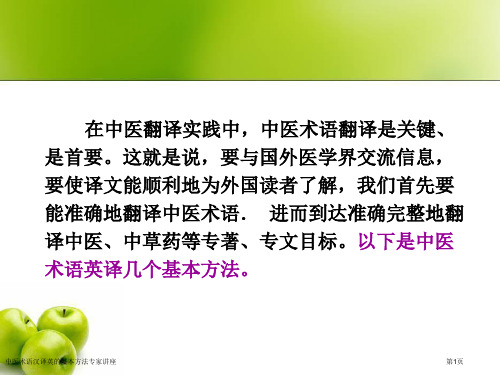
假如直译,无法正确表示出方剂正确功效;假如
依据功效意译,则英译名繁杂冗长,所以,依据方
剂汉语拼音对名称进行音译,是方剂惯用翻译
方法。比如:
玉屏风散 Yupingfeng San
仙方活命饮 Xianfang Huoming Yin
保济丸
Baoji Wan
中医术语汉译英的基本方法专家讲座
第14页
3)古典中医专著 《黄帝内经》 Huangdi Neijing 《伤寒论》 Shanghan Lun 《金匮要略》 Jingui Yaolue 《温病学》 Wenbing Xue
中医术语汉译英的基本方法专家讲座
第10页
泰山磐石散 细脉
Powder for calming fetus Thready Pulse
中医术语汉译英的基本方法专家讲座
第11页
三.音译
音译即拼音翻译法。因为中西方文化及中西医之 间巨大差异,中医理论中特有一些概念在英语 中极难找到对应语。如“气”、“阴阳”、“气
采取意译手法则能够得其“意义”而不拘泥于“字面”。
中医术语汉译英的基本方法专家讲座
第8页
因而,我们应该将金、木、水、火、土意译为lung,
liver, kidney, heart, spleen, 而不是译成metal,
water, fire, earth.
“木火刑金”可意译成liver fire impairing lung. 如
富,在英语中没有对应对应词。假如采取辞典式
释义方法,无疑违反了翻译简练性标准。因
此,采取音译是一个不得已但主要方法。
“阴”、“阳”、“神”、“脏”、“腑”、 “寸”、“关”、
“尺”、“风”、“气”、“命”可分别翻译成Yin,
中医英语翻译
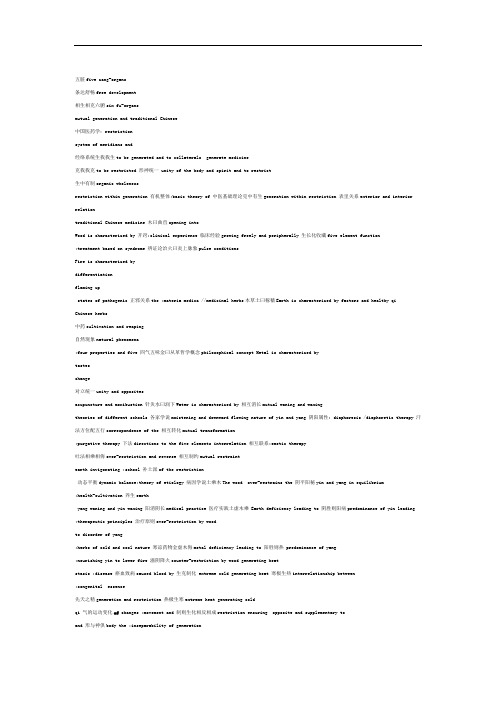
五脏five zang-organs条达舒畅free development相生相克六腑six fu-organsmutual generation and traditional Chinese中国医药学:restrictionsystem of meridians and经络系统生我我生to be generated and to collaterals generate medicine克我我克to be restricted 形神统一 unity of the body and spirit and to restrict生中有制organic wholenessrestriction within generation 有机整体:basic theory of 中医基础理论克中有生generation within restriction 表里关系exterior and interior relationtraditional Chinese medicine 木曰曲直opening intoWood is characterized by 开窍:clinical experience 临床经验growing freely and peripherally 生长化收藏five element function:treatment based on syndrome 辨证论治火曰炎上脉象pulse conditionsFire is characterized bydifferentiationflaming upstates of pathogenic 正邪关系the :materia medica //medicinal herbs本草土曰稼穑Earth is characterized by factors and healthy qi Chinese herbs中药cultivation and reaping自然现象natural phenomena:four properties and five 四气五味金曰从革哲学概念philosophical concept Metal is characterized bytasteschange对立统一unity and oppositesacupuncture and moxibustion 针灸水曰润下Water is characterized by 相互消长mutual waning and waxingtheories of different schools 各家学说moistening and downward flowing nature of yin and yang 阴阳属性: diaphoresis /diaphoretic therapy 汗法方位配五行correspondence of the 相互转化mutual transformation:purgative therapy 下法directions to the five elements interrelation 相互联系:emetic therapy吐法相乘相侮over-restriction and reverse 相互制约mutual restraintearth invigorating :school 补土派of the restriction动态平衡dynamic balance:theory of etiology 病因学说土乘木The wood over-restrains the 阴平阳秘yin and yang in equilibrium:health-cultivation 养生earthyang waning and yin waxing 阳消阴长medical practice 医疗实践土虚木乘 Earth deficiency leading to 阴胜则阳病predominance of yin leading :therapeutic principles 治疗原则over-restriction by woodto disorder of yang:herbs of cold and cool nature 寒凉药物金虚木侮metal deficiency leading to 阳胜则热 predominance of yang:nourishing yin to lower fire 滋阴降火counter-restriction by wood generating heatstasis :disease 瘀血致病caused blood by 生克制化 extreme cold generating heat 寒极生热interrelationship between:congenital essence先天之精generation and restriction 热极生寒extreme heat generating coldqi 气的运动变化of changes :movement and 制则生化相反相成restriction ensuring opposite and supplementary toand 形与神俱body the :inseparability of generationeach otherspirit传变physiological functions transmission of disease 生理功能 spirit/mental activity:神明母病及子disease of the mother-organ 病理变化pathological changes:zang-organs and fu-organs/viscera 脏腑affecting the child-organ临床诊断clinical diagnosis:functional activities 功能活动子病犯母organic wholeness/entirety 有机整体disease of the child-organ:unity of the body and spirit 形神统一affecting the mother-organbetween 正邪斗争struggle healthy qi and:imbalance of yin and yang 阴阳失调肝肾精血不足insufficiency of kidney pathogenic factorsand:struggle between healthy qi 正邪相争liver essence and blood绝对偏盛absolute predominanceand pathogenic factors 肝阳上亢deficiency yang 阳虚则寒hyperactivity of liver yang cold leading toprevention of disease 治未病藏象学说consumption of yang involving 阳损及阴 theory of visceralto cultivate health 调养manifestationsyinhealthy qi 正气五脏六腑insufficiency of yin-fluid 阴液不足 five zang-organs and sixpathogenic factor病邪fu-organs病机pathogenesisprevention and treatment of 疾病的防治奇恒之府五行学说theory of five elements extraordinary fu-organsdiseasecereal nutrients水谷精微motion and variation运动变化 concept of holism整体观念.传化水谷 transmissions and 潜阳息风suppressing yang to quench wind and pathology of the human body as wellas the diagnosis, prevention and interdependence of yin transformation of food 阴阳的互根互用treatment of disease.storage of essence and yang贮藏精气4. interior and exterior interdependence黄帝内经总结了春秋战国以来的医疗成相互依存表里关系就和治疗经验,确立了中医学独特的理论体relationship阴阳离决separation of yin and yang系,成为中医药学发展的基础。
No2 中医英语翻译的实践与探讨 Microsoft PowerPoint 演示文稿
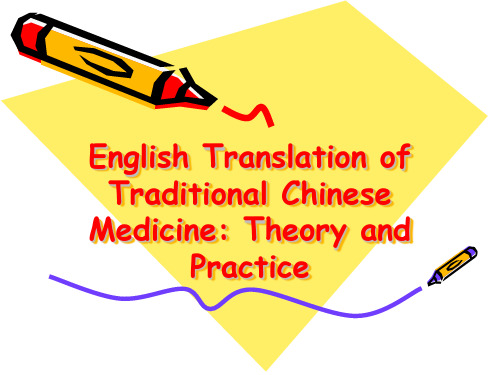
Medicine: Theory and Practice
1.阴阳五行
• “阴阳学说”常译作 • theory of yin and yang • doctrine of yin and yang。
“阴阳失调”
• 常译作 • imbalance between yin and yang • incoordination between yin and yang。 • 国外亦有译作yin-yang disharmony。 • 中医学上的“失调”有多种含义,在不
补肾tonifying kidney
• 补肾中药天癸方对雄激素致不孕大鼠胰 腺及卵巢雄激素受体的影响
• Effect of tonifying kidney herbs Tiangui Recipe on androgenreceptor levels of ovary and pancreas in androgen sterillized rats
• 《中华中医药杂志》2011年4月第26卷第4期:679 王 莉 复旦大学附属妇产医院
健脾: Invigorating Spleen
• 疏肝健脾方药对非酒精性脂肪性肝病大鼠 肝组织脂肪酸合成酶mRNA及蛋白表达的 影响
• Effect of Soothing Liver and Invigorating Spleen Recipes on Fas mRNA and protein expression in hepatic tissue of non-alcoholic fatty liver disease rats
• 基金资助:国家自然科学基金项目
翻译理论与实践知到章节答案智慧树2023年湖南中医药大学
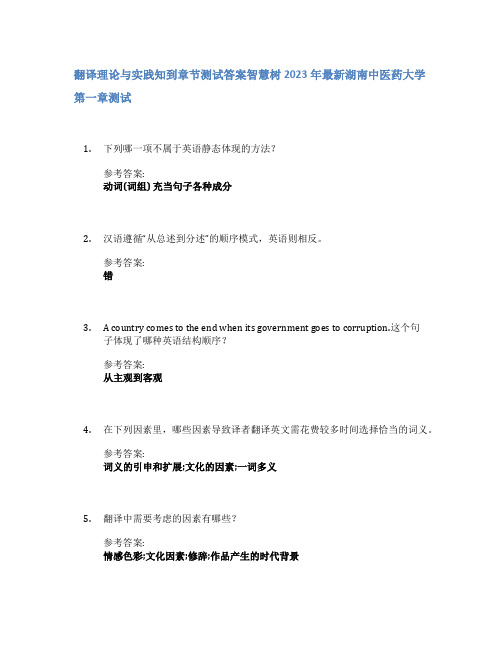
翻译理论与实践知到章节测试答案智慧树2023年最新湖南中医药大学第一章测试1.下列哪一项不属于英语静态体现的方法?参考答案:动词(词组) 充当句子各种成分2.汉语遵循“从总述到分述”的顺序模式,英语则相反。
参考答案:错3. A country comes to the end when its government goes to corruption.这个句子体现了哪种英语结构顺序?参考答案:从主观到客观4.在下列因素里,哪些因素导致译者翻译英文需花费较多时间选择恰当的词义。
参考答案:词义的引申和扩展;文化的因素;一词多义5.翻译中需要考虑的因素有哪些?参考答案:情感色彩;文化因素;修辞;作品产生的时代背景6.下列哪些模式适用于英语表达参考答案:焦点前置模式;上下主从层级模式;空间顺序模式7.下列哪一选项最符合翻译过程中迁就目标语表达模式?参考答案:null8.以下哪些句子体现了增词翻译原则中的修辞性增词:参考答案:At thirty-five, she had first learned what it is to be a mother. “她到35岁的时候才生平第一次尝到做母亲的滋味。
”;There has been too muchpublicity about the case. “那件案子已经搞得满城风雨,人尽皆知了。
”9.英语表达中,动词地位不平等是客观存在的事实,主要体现在参考答案:过去分词结构;不定式结构;现在分词结构;无动词结构10.汉语结构中主语缺失是一种十分普遍的现象,而英语中是不允许存在的。
参考答案:错第二章测试1.I hope to be able to come.这个句子体现的是不定式结构的哪种上下主从模式参考答案:主干动词+不定式的主从关系2.下列哪一项与其它选项过去分词结构体现的上下主从结构模式不一样参考答案:The river witnessed the growth of Chinese people.3.包含原则,是指一个相对较大的时间范围内包含某个精确时间点,在这个精确的时间点发生了某个事件,则以精确事件为焦点,作为主句,置于句首,而关于时间范围的事件,沦为背景信息,作为从句或从属成分,在句中居于偏后的位置。
中医英语课后翻译习题答案(全)

experience in their struggle against diseases. 2. 中医学有完整独特的理论体系。
TCM has a unique and integrative theoretical system. 3. 中医学是研究人的生命规律以及疾病的发生�发展和防治规律的一门科学。
TCM is a science that studies the rules of life as well as the occurrence, progress,
fivezangviscera2?六腑sixfuorgans3?经络系统systemofmeridiansandcollaterals4?整体观念holism5?有机整体organicwhole6?社会属性socialattribute7?开窍ofthefivezangorgansopeninto8?生长化收藏sproutinggrowingtransformingripeningandstoring9?诊断学diagnostics10?邪正关系relationshipbetweenpathogenicfactorsandhealthyqi11?治疗学therapeutics12?风寒感冒commoncoldduetowindandcold13?同病异治treatmentofthesamediseasewithdifferentremedies14?异病同治treatmentofdifferentdiseaseswiththesameremedy15?水液代谢平衡balanceofwatermetabolism16?清心火clearingawayheartfire17?疾病本质natureofdisease18?以左治右treatingtheleftsideforcuringdiseaseslocatedontherightside19?从阴引阳drawingyangfromyin20?病在上者下取之treatingthelowerpartforcuringdiseaseslocatedontheupperpart1?中医理论体系有两个基本特点?一是整体观念?二是辨证论治
中医英语翻译理论
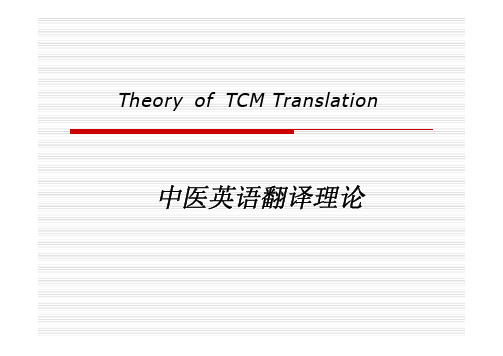
1 中医翻译概论
� 1.2 定义化
� 中医术语高度凝炼,难以用同样长短的英语表达清楚 � 翻译往往以解释、定义方式進行 � 辨证论治
� diagnosis and treatment based on the overall analysis of symptoms and signs
� 虚胀 � Flatulence due to yang-deficiency of the spleen and kidney
3 中医翻译实践
� 3.2 直译 � � � � � 阴阳失调 脾失健运 肝不藏血 胃失和降 肾阳不足
� yin-yang disharmony / imbalance between yin and yang spleen failing to move and transform / dysfunction of spleen; failure of spleen in transportation liver failing to store blood / inability of the liver to store blood impaired harmonious downbearing of the stomach / failure of gastric qi to descend insufficiency of kidney yang / insufficiency of renal yang
� � � � � � 心悸 便秘 便溏 遗尿 黄疸 纳呆 � � � � � � palpitation constipation loose / sloppy stool enuresis / incontinence* jaundice anorexia*, poor appetite / torpid intake
中医英语翻译

中国医药学:traditional Chinese medicine中医基础理论:basic theory of traditional Chinese medicine临床经验:clinical experience辨证论治:treatment based on syndrome differentiation本草:materia medica国医药学有数千年的历史,是中国人民长期同疾病作斗争的经验总结。
TCM, a medical system with a history of thousands years,has summarized the experience of the Chinese people accumulating in the struggle against diseases.2.中医学在古代唯物论和辩证法思想的影响和指导下,通过长期的医疗实践,逐步形成并发展为独特的医学理论体系。
Under the influence andguidance of classicalChinese materialism anddialectics,traditionChinese medicine haseventually evolved into amedical system withunique theory throughlong term medicalpractice.3.中医学是研究人体生理病理以及疾病的诊断和防治的一门科学。
Tradition Chinesemedicine is a sciencefocusing on the study ofthe physiology andpathology of the humanbody as well as thediagnosis, prevention andtreatment of disease.4.黄帝内经总结了春秋战国以来的医疗成就和治疗经验,确立了中医学独特的理论体系,成为中医药学发展的基础。
《中医入门》(节选)汉英翻译实践报告
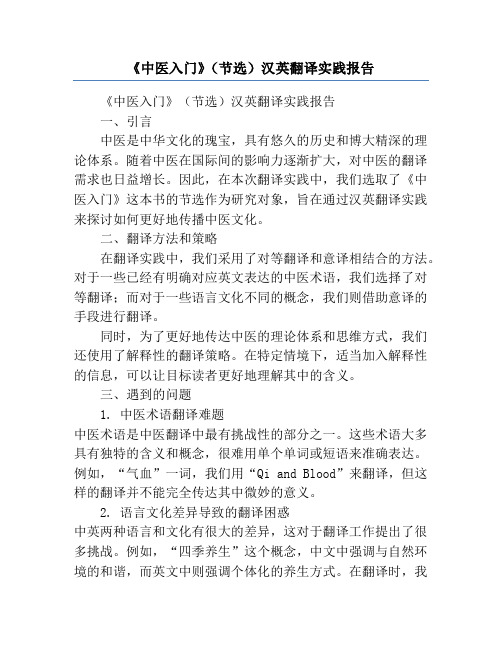
《中医入门》(节选)汉英翻译实践报告《中医入门》(节选)汉英翻译实践报告一、引言中医是中华文化的瑰宝,具有悠久的历史和博大精深的理论体系。
随着中医在国际间的影响力逐渐扩大,对中医的翻译需求也日益增长。
因此,在本次翻译实践中,我们选取了《中医入门》这本书的节选作为研究对象,旨在通过汉英翻译实践来探讨如何更好地传播中医文化。
二、翻译方法和策略在翻译实践中,我们采用了对等翻译和意译相结合的方法。
对于一些已经有明确对应英文表达的中医术语,我们选择了对等翻译;而对于一些语言文化不同的概念,我们则借助意译的手段进行翻译。
同时,为了更好地传达中医的理论体系和思维方式,我们还使用了解释性的翻译策略。
在特定情境下,适当加入解释性的信息,可以让目标读者更好地理解其中的含义。
三、遇到的问题1. 中医术语翻译难题中医术语是中医翻译中最有挑战性的部分之一。
这些术语大多具有独特的含义和概念,很难用单个单词或短语来准确表达。
例如,“气血”一词,我们用“Qi and Blood”来翻译,但这样的翻译并不能完全传达其中微妙的意义。
2. 语言文化差异导致的翻译困惑中英两种语言和文化有很大的差异,这对于翻译工作提出了很多挑战。
例如,“四季养生”这个概念,中文中强调与自然环境的和谐,而英文中则强调个体化的养生方式。
在翻译时,我们必须在保持原意的基础上,做到精确而自然的表达。
四、解决方法和经验总结1. 注意语言风格的适应英语和汉语有不同的表达习惯和风格。
在翻译中,我们要注意适应英语语境和读者习惯,使翻译更符合目标读者的理解和接受。
2. 注重信息选择和加工在中医翻译中,有时需要舍弃一些无法准确翻译的信息,保留重要的关键词或概念。
同时,我们还要根据目标读者的背景和知识水平,加工信息,以保证翻译的准确性和可读性。
3. 增进专业知识和跨学科素养为了更好地完成中医翻译工作,我们需要增进对中医理论的理解和专业知识的积累。
同时,也需要拓展跨学科的知识,以便更好地应对中医文化的翻译挑战。
中医英语术语
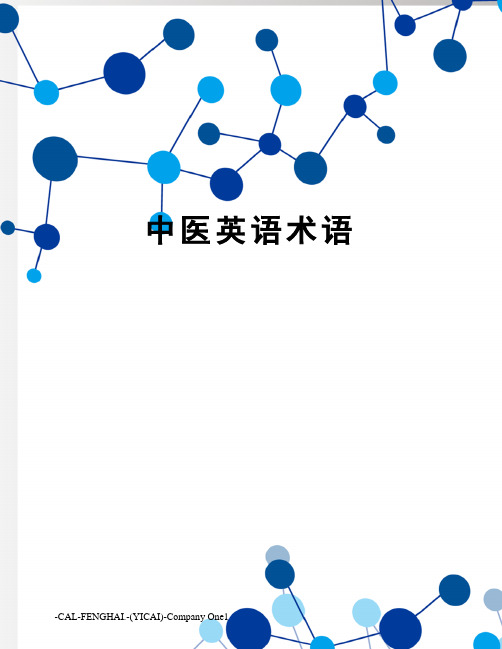
中医英语术语-CAL-FENGHAI.-(YICAI)-Company One1第一课1.中国中医药traditional Chinese medicine; TCM中医基础理论basic theory of traditional Chinese medicine临床经验clinical experience辨证论治treatment based on syndrome differentiation 杂病miscellaneous diseases中药学Chinese pharmacy 四气五味four properties and five tastes针灸acupuncture and moxibustion; acumox古代中国哲学classical Chinese philosophy汗法sweating therapy; diaphoresis 下法purgation吐法vomiting therapy; emetic therapy补土派the School of Reinforcing the Earth方剂prescription; formula医疗实践medical practice治疗原则therapeutic principles寒凉药herbs cold and cool in nature滋阴降火nourishing yin and reducing fire瘀血致病diseases caused by blood stagnation第二课1 ve zang-organs; five zang-viscera五脏six fu-organs六腑system of meridians and collaterals经络系统holism整体观念organic wholenss有机整体social attribute社会属性(of the five zang-organs) open into开窍sprout, grow, transform, ripen and store生长化收藏diagnostics诊断学relationship between pathogenic factors and healthy qi邪正关系therapeutics治疗学common cold due to wind and cold风寒感冒different therapeutic methods used to treat the same disease同病异治the same therapeutic method used to treat different diseases异病同治balance of water metabolism水液代谢平衡clearing away heart fire清心火nature of disease疾病本质treating the left side for curing diseases located on the right side 以左治右drawing yang from yin从阴引阳treating the lower part for curing diseases located on the upper part病在上者下取之第三课1 philosophical concept哲学概念mutual transformation相互转化balance of yin and yang阴平阳秘transformation between yin and yang阴阳转化extreme cold turning into heat寒极生热pathological changes病理变化absolute predominance 绝对偏盛general rule of pathogenesis病机总纲supplementing what it lacks of补其不足eliminating wind and dispersing cold祛风散寒mutually inhibiting and promoting相互消长mutually inhibiting and restraining相互制约interdependence相互依存excess of yin leading to decline of yang阴胜则阳病contrary and supplementary to each other相反相成organic whole有机整体impairment of yang involving yin阳损及阴deficiency of both yin and yang阴阳两虚deficiency cold syndrome虚寒证suppressing yang and eliminating wind熄风潜阳第四课1.the doctrine of five elements; the theory of five phases五行学说free development 条达舒畅to be generated and togenerate生我我生restraint in generation生中有制Wood is characterized by growing freely and peripherally.木曰曲直Earth is characterized by cultivation and reaping.土元稼穑Water is characterized by moistening and downward flowing.水曰润下over restriction and counter-restriction相乘相侮Wood over restricts earth because it is deficient.土虚木乘promotion, restriction, inhibition and transformation生克制化disorder of a mother-organ involving its child-organ母病及子insufficiency of essence and blood in the liver and kidney肝肾精血不足blood deficiency in the heart and liver心肝血虚exuberant fire in the heart心火亢盛insufficiency of liver yin肝肾不足declination of kidney yang肾阳衰微weakness of the spleen and stomach脾胃虚弱soothing the liver and harmonizing the stomach平肝和胃 insufficiency of kidney yin肾阴不足balance between water and fire水火不济第五课doctrine of visceral manifestations脏象学说five zang-organs and six fu-organs五脏六腑extraordinary fu-organs齐桓之府nutrients of water and food水谷精微ransmitting and transforming water and food传化水谷storing essence贮藏精气internal and external relationship表里关系therapeutic effects治疗效应clinical practice临床实践storage without discharge藏而不写discharge without storage泻而不藏physical build and various orifices形体诸窍(of five zang-organs) open into开窍spirit and emotions精神情志the heart storing spirit心藏神the lung storing corporeal soul肺藏魄the liver storing ethereal soul肝藏魂the spleen storing consciousness 脾藏意the kidney storing will肾藏志the luster manifesting upon the face其华在面第六课the heart governing blood and vessels心主血脉sufficiency of heart qi心气充沛rosy complexion面色红润sufficiency ofblood血液充盈unsmooth vessels脉道不利lusterless complexion面色无华thin and weak pulse脉象细弱the heart storing spirit心藏神sweat and blood sharing the same origin汗血同源ascending, descending, going out and going in升降出入dispersion, purification and descent宣发肃降regulating water passage通调水道the spleen governing transportation and transformation脾主运化nutrients of water and food水谷精微stoppage of water and fluid水液停滞acquired base of life 后天之本regulating qi activity调畅气机upward adverse flow of liver qi肝气上逆innate essence先天之精the kidney receiving qi肾主纳气第七课extraordinary fu-organs齐桓之府isolated fu-organ孤府digest water and food腐熟水谷anus破门remaining part of liver qi肝之余气upper energizer上焦separating the lucid from the turbid泌别清浊residue of foods食物残渣The large intestine governs thin body fluid大肠主津bile精汁The small intestine governs thick body fluid小肠主液primary digestion初步消化essential qi精气the seven important portals七冲门The gallbladder is responsible for making judgment胆主决断discharge waste排泄糟粕occurrence of menstruation月经来潮epiglottis 吸门morphological hollowness形态中空transporting and transforming water and food传化水谷第八课innateness先天禀赋nutrients; refined substance精微物质blood circulation血液循环water metabolism水液代谢way of qi movement气的运动形式ascending, descending, exiting and entering movements of qi的升降出入运动normal function of qi activity气机条畅primary motive force of life生命的原动力warming and nourishing the viscera温养脏腑qi of the viscera and meridians脏腑经络之气qi activity气机qi transformation气化innate qi先天之气acquired qi 后天之气healthy qi正气pathogenic factors邪气primordial qi元气thoracic qi宗气nutritive qi营气defensive qi卫气第九课qi promoting the production of blood气生血qi promoting the flow of blood气行血qi commanding blood气摄血blood carrying qi血载气blood generating qi血生气qi promoting the production of body fluid气生津液qi promoting the flow of body fluid气行津液qi commanding body fluid气摄津液body fluid carrying qi津液载气body fluid generating qi津液生气body fluid and blood sharing the same origin津血同源exhaustion of qi due to loss of body fluid气随液脱exhaustion of qi due to hemorrhage 气随血脱loss of qi due to profuse sweating气随津泄Normal flow of qi ensures normal flow of blood while stagnation of qi causes stagnation of blood.气行则血行气滞则血瘀Qi commands the blood and the blood carries qi.气为血帅血为气母Normal flow of qi ensures normal flow of body fluid while stagnation of qi causes stagnation of body fluid.气行则水行气滞则水滞nourishing qi to stop collapse益气固脱Sweating therapy should be not be used to treat patients suffering from hemorrhage.亡血家不可发汗Sweating therapy should not be used to treat hemorrhage.夺血者无汗第十课theory of meridians and collaterals经络学说system of meridians and collaterals经络系统transporting qi and blood to the whole body运行全身气血being connected with the viscera and limbs联络脏腑肢节running routes循行路线twelve regular meridians十二正经the regions through or along which the meridians run and the order by which the meridians are connected with each other循行部位和交接顺序(of a collateral) pertaining to a certain meridian络属关系eight extraordinary vessels (meridians)奇经八脉branches of the twelve regular meridians十二经别divergent collaterals别络skin divisions of the twelve regular meridians十二皮部tendons of the twelve regular meridians十二经筋qi of meridians经络之气syndrome differentiation of meridians and collaterals经络辨证meridian conduction经络感传meridian manifestations经络现象blockage of meridians经络阻滞soothing meridians and activating collaterals舒筋活络collateral pricking and cupping therapy刺络拔罐第十课theory of meridians and collaterals经络学说system of meridians and collaterals经络系统transporting qi and blood to the whole body运行全身气血being connected with the viscera and limbs联络脏腑肢节running routes循行路线twelve regular meridians十二正经the regions through or along which the meridians run and the order by which the meridians are connected with each other循行部位和交接顺序(of a collateral) pertaining to a certain meridian络属关系eight extraordinary vessels (meridians)奇经八脉branches of the twelve regular meridians十二经别divergent collaterals别络skin divisions of the twelve regular meridians十二皮部tendons of the twelve regular meridians十二经筋qi of meridians经络之气14 syndrome differentiation of meridians and collaterals经络辨证meridian conduction经络感传meridian manifestations经络现象blockage of meridians经络阻滞soothing meridians and activating collaterals舒筋活络collateral pricking and cupping therapy刺络拔罐Lesson 11six exogenous pathogenic factors外感六淫improper diet and overstrain 饮食劳倦common cold due to wind-cold风寒感冒diarrhea due to damp-heat/damp-heat diarrhea 湿热泄泻five endogenous pathogenic factors内生五邪pathogenic wind attacking the exterior 风邪外袭migratory arthralgia/joint pain游走性关节痛wind being the leading pathogenic factor风为百病之长 attacked/invaded by pathogenic cold感受寒邪decline of yang qi阳气衰退 cold tending to stagnate by nature寒性凝滞 stagnation of interstitial space 腠理闭塞spasm and contraction of muscles and tendons经脉拘急收引pathogenic dampness obstructing the spleen湿邪困脾inactivation of spleen-yang脾阳不振production of endogenous heat due to yin deficiency阴虚生内热extreme heat producing wind热极生风internal impairment due to yin deficiency 七情内伤improper diet饮食不节engorgement 暴饮暴食Lesson 12occurrence, development, and changes of disease疾病的发生发展变化(body )constitutional state 体质强弱dysfunction of qi and blood气血功能紊乱various pathological changes多种多样的病理变化exuberance or decline of pathogenic factors and healthy qi/ strength contrast between pathogenic factors and healthy qi邪正盛衰deficiency or excess changes of disease /transformation between deficiency and excess during a disease病症的虚实变化the human body’resistance against diseases 人体的抗病能力feverish sensation over the five centers (palms, soles, and chest)五心烦热deficiency complicated with excess虚实夹杂turnover of disease/prognosis of disease疾病转归 relative predominance of yin or yang 阴阳偏盛extreme changes of five emotions五志过极depletion of essence causing deficiency精气夺则虚mutual consumption of yin and yang阴阳互损true heat and false cold; false cold and true heat真热假寒或假寒真热stagnation of qi activity气机瘀滞不畅disorder of fluid metabolism津液代谢失常endogenous cold/ cold originating from the interior 寒从中生fluid consumption producing dryness津伤化燥stirring of endogenous wind/disturbance of endogenous wind风气内动Lesson 13spirit, complexion, and physical conditions 神色形态mental activities 精神活动sufficient essence and abundant qi精气充足apathetic facial expressions表情淡漠 normal complexion and varied normal complexion 主色与客色convulsion of the limbs四肢抽搐stirring of wind due to damp-heat湿热风动interior sinking of pathogenic toxin邪毒内陷scaly skin/ squamous and dry skin肌肤甲错hunger without appetite饥不欲食combined use of the four diagnostic methods四诊合参facial expressions面部表情favorable prognosis预后良好dispiritedness 精神不振five colors indicating diseases / diagnostic significance of five colors五色主病 facial distortion口角歪斜flaming of deficient fire虚火上炎retention of heat in the large intestine大肠热结mirror-like tongue光剥舌pulse manifestations脉象Lesson 14prevention before occurrence未病先防harmony between qi and blood气血平和regulating mental conditions调摄精神smooth circulation of blood血脉流畅smooth movement of joints关节通利smooth flow of qi/ free activity of qi气机条畅prolonging life and promoting longevity益寿延年preventive and therapeutic principles防治原则treatment should focus on the root of diseases治病求本treating secondary symptoms in acute disease急则治其标treating primary symptoms in chronic disease缓则治其本simultaneous treatment of primary and secondary symptoms 标本兼治deficiency of healthy qi and excess of pathogenic factors正虚邪实removing parasites to eliminate accumulation驱虫消积accumulation of phlegm-dampness in the lung痰湿壅盛blood serving as the mother of qi血为气母treatment in accordance with seasons, locality and individuality.因时因地因人制宜avoiding cold herbs in cold weather用寒远寒exogenous dry disease in autumn 外感秋燥moistening dryness with pungent and cool herbs辛凉润燥Lesson 15ⅰ.treatment with syndrome differentiation/ 辨证论治disease involving both exterior and interior表里同病 simultaneous occurrence of cold and heat/ mixture of cold and heat寒热错杂regression of interior pathogenic factors to the exterior 里邪出表true cold and false heat 真寒假热aversion to cold and aversion to heat恶寒与恶热tasteless sensation in the mouth without thirst 口淡不渴transformation of stagnated pathogenic cold into heat 寒邪郁而化热exterior-deficiency syndrome due to exogenous pathogens外感表虚feverish sensation over five centers五心烦热location and nature of disease病位与病性mixture of deficiency and excess虚实夹杂invasion of exterior pathogenic factors into the interior表邪入里cold syndrome transforming into heat syndrome寒症化热true heat and false cold真热假寒heat syndrome transforming into cold syndrome热证转寒pale tongue with white, moist and slippery fur舌淡苔白而润滑rapid and weak pulse脉数无力tidal fever and night sweating 潮热盗汗coma with delirium神昏谵语 Lesson 16Chinese medicinal herbs 中草药four properties and five flavors 四气五味the part used for medical purpose入药部分collection of herbs药物采集processing of herbs 炮制eliminating impurity清除杂质mild effect作用和缓relieving exterior syndrome by dispersion发散解表astringing and checking收敛固涩lubricant purgation by softening hardness 软坚润下drying dampness to invigorate the spleen燥湿健脾ascending, descending, sinking and floating升降沉浮channel tropism/channel distribution of medicines归经medication contraindication用药禁忌dosage药物剂量pungent and warm herbs with the function of relieving exterior syndrome 辛温解表药herbs for expelling wind and dampness祛风湿药eighteen incompatible herbs and nineteen herbs of mutual antagonism十八反十九畏herbs for clearing away heat and cooling blood清热凉血药herbs foreliminating phlegm and stopping cough祛痰止咳药Lesson 17Science of prescription方剂学compatibility配伍关系prescription-formulating principle组成规律modification of prescriptions方剂的加减drug form and dosage 剂型与剂量monarch, minister, assistant and guide君臣佐使toxicity of medicinal herbs药物毒性 moderating the property of herbs 缓和药性guiding action引经报使mediating all herbs in a prescription调和诸药warming channels to dissipate cold温经散寒dispersing lung to relieve asthma宣肺平喘flexible modification灵活化裁clearing away and dispersing stagnated heat 清散郁热modification according to symptoms随症加减processed herbs药物饮片power for oral taking内服散剂medicinal extract for external application 外用膏剂mixed in boiled water for oral taking开水冲服condensed extract浓缩浸膏 Lesson 18acupuncture and moxibustion therapy针灸疗法reinforcing and reducing techniques for needling针刺补泻needling techniques针刺手法methods for needle-inserting进针手法alleviating pain with acupuncture针刺止痛acupuncture anesthesia针刺麻醉needling sensation 针感intradermal needle皮内针angle and depth of needling针刺的角度和深度insertion of needle with double hands双手进针 manipulation of needle行针ear acupuncture therapy耳针疗法lifting, thrusting, twisting and rotating 提插捻转water-acupuncture therapy水针疗法scalp-acupuncture therapy头针疗法blistering moxibustion 化脓灸scarring moxibustion瘢痕灸moxibustion with moxa cone艾炷灸 lamp moxibustion灯火灸needle-warming moxibustion温针灸Lesson 19tuina manipulations推拿手法alleviating pain减轻疼痛exercise for practicing tuina功法训练relaxing muscles放松肌肉relieving muscular tension解除肌肉紧张restricted activity活动受限dislocation of joint关节脱位protrusion of lumbar vertebral disc腰椎间盘突出rotating reduction旋转复位injury of soft tissue软组织损伤adhesion and stiffness of joint 关节粘连僵硬lubricating joint滑利关节reinforcing and reducing manipulation手法补写horizontal pushing with the thumb拇指平推法pushing manipulation with one finger一指禅推法point-pressing manipulation点按法kneading manipulation with the large thenar大鱼际揉法alternated rubbing and kneading交替搓揉injury of lumbar muscles腰肌劳损vertical exertion of force 垂直用力Lesson 20differentiation of tongue manifestations辨舌象differentiation of pulse manifestations辨脉象balancing expelling pathogenic factors with strengthening healthy qi 正邪兼顾thoracic retention of fluid支饮chills in the back/aversion to cold in the back背部恶寒dark complexion/black complexion面色黧黑slippery tongue coating/ moist and glossy tongue coating舌苔水滑taut pulse/wiry pulse 弦脉dispelling pathogenic cold发散寒邪invigorating the stomach to resolve fluid健胃化饮nourishing kidney water to astringe lung qi滋肾水以敛肺气nourishing yin blood to protect liver yin养阴血以护肝阴expelling pathogenic factors without impairing the healthy qi祛邪而不伤正invigorating qi to harmonize the middle-jiao益气和中mediating all herbs in a prescription调和诸药prescriptions for drastic diaphoresis发汗峻剂cold in the exterior and fluid in the interior表寒里饮cold water attacking the stomach水寒犯胃effective prescriptions有效方剂cold limbs in syncope 手足厥冷Lesson 21complementary therapy补充疗法alternative medicine 替代医学rehabilitation process康复过程side-effects副作用active ingredients 有效成分evidence-based data 询证数据double-blind randomized trial双盲随机试验stroke onset中风发病hyper-acute stage超急性期proprietary medicine 专利药品animal models动物模型risk of bleeding出血的危险因素mechanism of action作用机制low-quality medical treatments医疗质量低下 physiotherapy物理疗法 neuroplasticity 神经可塑性mainstream medicine 主流药物antiplatelet agent抗血小板剂microbial analysis微生物分析heavy metal research 重金属研究。
中医英语翻译理论与实践
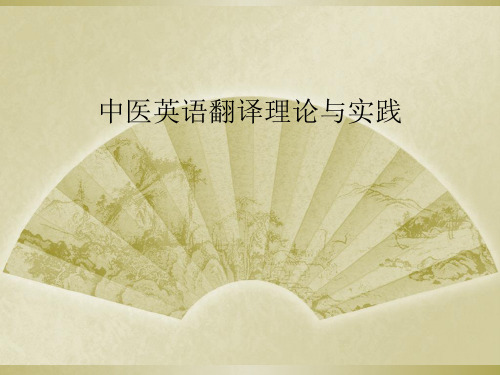
黄帝曰:“惜时与卿等谈医论药 ,旨在救天下万民于忧患,非为 吾华夏一族所计。朕观日月交辉 ,忧人世多艰。愿昔时所厘之医 道广播四海,咸宁万国。”
Huangdi said: “I have established this system of medicine for people all over the world, not just for the Chinese nation. I hope that it can be disseminated and practiced over the world.”
黄帝曰:“四异之邦与吾华夏 言语不通,嗜欲不同。华夏医 道,何以传之于彼?”
Huangdi said: “The languages spoken in these countries and areas are different from the Chinese language. How was the Chinese medicine disseminated to these places?”
诏命其精研译道,传译华医于泰 西,以使万国咸宁,天下安康。
雷公稽首再拜曰:“谨遵圣意。 ”
When you have found such erudite scholars, ask them to carefully study the methods of translation and translate Chinese medicine into Western languages.”
Qibo answered: “China now is stable and peaceful. The government pays much attention to education. Qualified translators can certainly be found in this country with such a great ancient civilization. Your Majesty may send an official from the Heaven to the world of man to
中医英语翻译理论和实践课件
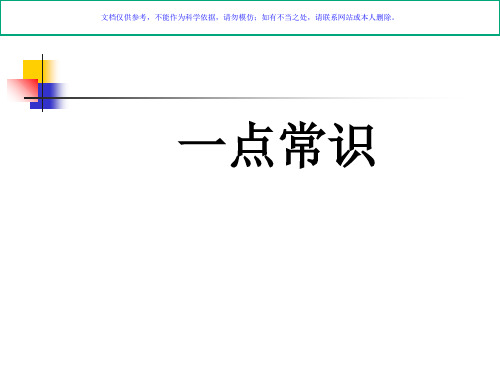
side in attendance.
黄帝曰:“惜时与卿等谈医论药 文档仅供参考,不能作为科学依据,请勿模仿;如有不当之处,请联系网站或本人删除。
,旨在救天下万民于忧患,非为 吾华夏一族所计。朕观日月交辉 ,忧人世多艰。愿昔时所厘之医 道广播四海,咸宁万国。”
Huangdi said: “I have established this system of medicine for people all over the world, not just for the Chinese nation. I hope that it can be disseminated and practiced over the world.”
黄帝曰:“吐蕃、西域及朔方 文档仅供参考,不能作为科学依据,请勿模仿;如有不当之处,请联系网站或本人删除。 之大部今属中国之地;高丽、 扶桑、交趾皆为儒学昌盛之邦 。华夏医道传之其地当无山隔 水断之忧。
黄 帝曰 : “ 四异 之邦 与吾 华夏 文档仅供参考,不能作为科学依据,请勿模仿;如有不当之处,请联系网站或本人删除。
言语不通,嗜欲不同。华夏医 道,何以传之于彼?”
Huangdi said: “The languages spoken in these countries and areas are different from the Chinese language. How was the Chinese medicine disseminated to these places?”
中医古籍英译翻译理论

中医古籍英译翻译理论中医古籍英译翻译理论中医古籍是中国传统医学的重要组成部分,涵盖了从传统疗法到经验和观念上的全部知识。
随着中国文化的全球化,中医古籍的英译翻译也受到了越来越多的关注。
因此,探讨中医古籍英译翻译理论的研究也成为当前许多学者研究的热点。
一、中医古籍的历史渊源中医古籍的英译翻译理论,首先要了解其历史渊源。
中国的古医学起源于公元前2600年的商代,当时已经出现了以《黄帝内经》为代表的古籍,其中对中医理论、疗法、药物等均有所记载。
古代中医学著作在汉代有了质的飞跃,陆羽的《伤寒论》、张仲景的《千金方》等著作,构成了中国古代医学的三大经典。
此外,清朝时期的《本草纲目》、《伤寒杂病论》等也构成了清代医学的重要组成部分,为中医古籍积累了丰富的知识储备。
二、中医古籍英译翻译理论中医古籍英译翻译理论,首先要明确翻译的目标和原则。
一般来说,翻译的目标是以文化、语言和信息传递的完整性为前提,尽可能恰当地传达原文的意义。
其次,翻译者必须掌握中医古籍中的语言、文化和历史背景,以便恰当地译出中医古籍中的含义。
另外,翻译者还要具备一定的翻译技巧,比如语言的精准性、文章的连贯性和信息的准确性,以保证翻译的质量。
此外,翻译者还要结合当今的社会文化环境,灵活运用语言,以便更好地传达中医古籍中的文化和思想。
三、中医古籍英译翻译的重要意义中医古籍英译翻译具有重要的意义,首先可以促进中国传统医学的国际化,推动中医古籍的广泛传播,让全世界的人们都能够深入了解中国传统医学。
此外,中医古籍英译翻译还可以拓展临床研究领域,更好地促进中医药的发展和应用。
最后,中医古籍英译翻译还可以激发中国传统医学的新活力,为临床实践和科学研究提供有力的支持,从而为全世界的患者带来更多的治疗效果。
四、结论中医古籍英译翻译理论是一个十分重要的研究课题,它不仅有助于中国传统医学的国际化,而且还可以提高中医药的科学研究和实践水平,从而为全世界的患者带来更多的治疗效果。
中医英语术语翻译

中医英语术语翻译(总5页)--本页仅作为文档封面,使用时请直接删除即可----内页可以根据需求调整合适字体及大小--Unit 11 中国医药学traditional Chinese medicine; TCM2中医基础理论basic theory of traditional Chinese medicine3临床经验clinical experience4辨证论治treatment based on syndrome differentiation5杂病miscellaneous diseases6中药学Chinese pharmacy7四气五味four properties and five tastes8针灸acupuncture and moxibustion; acumox9古代中国哲学classical Chinese philosophy10汗法sweating therapy; diaphoresis11下法purgation12吐法vomiting therapy; emetic therapy13补土派the School of Reinforcing the Earth14病因学etiology15方剂prescription; formula16医疗实践medical practice17治疗原则therapeutic principles18寒凉药物herbs cold and cool in nature19滋阴降火 nourishing yin and reducing fire20瘀血治病diseases caused by blood stagnationUnit21五脏five zang-organs; five zang-viscera2六腑six fu-organs3经络系统system of meridians and collaterals4整体观念holism5有机整体organic wholenss6社会属性social attribute7开窍(of the five zang-organs) open into8生长化收藏sprout, grow, transform, ripen and store9诊断学diagnostics10邪正关系relationship between pathogenic factors and healthy qi11治疗学therapeutics12风寒感冒common cold due to wind and cold13同病异治different therapeutic methods used to treat the same disease14异病同治the same therapeutic method used to treat different diseases15水液代谢平衡balance of water metabolism16清心火clearing away heart fire17疾病本质nature of disease18以左治右treating the left side for curing diseases located on the right side19从阴引阳drawing yang from yin20.病在上者下取之treating the lower part for curing diseases located on the upper part Unit 31哲学概念philosophical concept2.相互转化mutual transformation3.阴平阳秘balance of yin and yang4.阴阳转化transformation between yin and yang5.寒极生热extreme cold turning into heat6.病理变化pathological changes7.绝对偏盛absolute predominance8.病机总纲general rule of pathogenesis9.补其不足supplementing what it lacks of10.祛风散寒 eliminating wind and dispersing cold11.相互消长 mutually inhibiting and promoting;wax and wane between yin and yang12.相互制约 mutually inhibiting and restraining13.相互依存 interdependence14.阴胜则阳病excess of yin leading to decline of yang15.相反相成 contrary and supplementary to each other16.有机整体 organic whole17.阳损及阴 impairment of yang involving yin18.阴阳两虚 deficiency of both yin and yang19.虚寒证deficiency cold syndrome20.潜阳熄风 suppressing yang and eliminating windUnit41 the theory of five elements 五行学说2 free development 条达舒畅3 to be generated and to generate生我,我生4 restraint in generation 生中有制5 over restriction and counter-restriction相乘相侮6 Wood over restricts earth because it is deficient.土虚木乘7 promotion, restriction, inhibition and transformation 生克制化8 disorder of a mother-organ involving its child-organ 母病及子9 insufficiency of essence and blood in the liver and kidney 肝肾精血不足10 blood deficiency in the heart and liver 心肝血虚11 exuberant fire in the heart心火亢盛12 insufficiency of liver yin 肝阴不足13 declination of kidney yang肾阳式微14 weakness of the spleen and stomach 脾胃虚弱15 soothing the liver and harmonizing the stomach 平肝和胃16 between water and fire水火不济Unit51 藏象学说doctrine of visceral manifestations2 五脏六腑five zang-organs and six fu-organs3 奇恒之腑extraordinary fu-organs4 水谷精 of water and food5 传化水谷transmitting and transforming water and food6 贮藏精气storing essence7 表里关系internal and external relationship8 治疗效应therapeutic effects9 临床实践clinical practice10 藏而不泻storage without discharge11泻而不藏discharge without storage12形体诸窍physical build and various orifices13开窍(of five zang-organs) open into14精神情志spirit and emotions15心藏神the heart storing spirit16肺藏魄the lung storing corporeal soul17肝藏魂the liver storing ethereal soul18脾藏意the spleen storing consciousness19肾藏志the kidney storing will20其华在面the luster manifesting upon the faceUnit61 心主血脉 the heart governing blood and vessels2 心气充沛 sufficiency of heart qi3 面色红润 rosy complexion4 血液充盈 sufficiency of blood5 脉道不利 unsmooth vessels6 面色无华 lusterless complexion7 脉象细弱 thin and weak pulse8 心藏神 the heart storing spirit9 汗血同源 sweat and blood sharing the same origin10 升降出入 ascending, descending, going out and going in11宣发肃降 dispersion, purification and descent12通调水道 regulating water passage13脾主运化 the spleen governing transportation and transformation 14水谷精 of water and food15水液停滞 stoppage of water and fluid16后天之本 acquired base of life17调畅气机 regulating qi activity18肝气逆上 upward adverse flow of liver qi19先天之精 innate essence20肾主纳气 the kidney receiving qiUnit71 奇恒之府extraordinary fu-organs2 孤俯isolated fu-organ3 腐熟水谷digest water and food4 魄门anus5 肝之余其surplus part of liver qi6 上焦upper energizer7 泌别清浊separating the lucid from the turbid8 食物残渣residue of foods9 大肠主津The large intestine governs thin body fluid10精汁(胆汁)bile11小肠主液The small intestine governs thick body fluid12初步消化primary digestion13精气essential qi14七冲门the seven important portals15胆主决断The gallbladder is responsible for making judgment16排泄糟粕discharge waste17月经来潮occurrence of menstruation18吸门inhaling portal19形态中空morphological hollowness20传化水谷transporting and transforming water and foodUnit81 先天禀赋innateness2 精微物质nutrients; refined substance3 血液循行blood circulation4 水液代谢water metabolism5 气的运动形式way of qi movement6 气的升降出入ascending, descending, exiting and entering movements of qi7 气机调畅normal function of qi activity8生命的原动力primary motive force of life9 温养腑脏warming and nourishing the viscera10 腑脏经络之气qi of the viscera and meridians11气机qi activity12气化qi transformation13先天之气innate qi14后天之气acquired qi15正气healthy qi16邪气pathogenic factors17元气primordial qi18宗气thoracic qi19营气nutritive qi20卫气defensive qi21腠理striae and intersticesUnit91气生血qi promoting the production of blood2气行血qi promoting the flow of blood3气摄血qi commanding blood4血载气blood carrying qi5血生气blood generating qi6气生津液qi promoting the production of body fluid7气行津液qi promoting the flow of body fluid8气摄津液qi commanding body fluid9津液载气body fluid carrying qi10津液生气body fluid generating qi11津血同源body fluid and blood sharing the same origin12气随液脱exhaustion of qi due to loss of body fluid13气随血脱exhaustion of qi due to hemorrhage14气随津泄loss of qi due to profuse sweating15气行则血行,气滞则血瘀。
- 1、下载文档前请自行甄别文档内容的完整性,平台不提供额外的编辑、内容补充、找答案等附加服务。
- 2、"仅部分预览"的文档,不可在线预览部分如存在完整性等问题,可反馈申请退款(可完整预览的文档不适用该条件!)。
- 3、如文档侵犯您的权益,请联系客服反馈,我们会尽快为您处理(人工客服工作时间:9:00-18:30)。
及谙熟之,并携医经药典还国, 以华文传于其地。故今之日文多 杂以华字。朝韩越国,旧亦书华 文行儒学。”
After returning their countries, they practiced and taught Chinese medicine through the media of Chinese characters. That is why today Chinese characters still can be found in Japanese written language.”
岐伯对曰:“诸四异之邦文在初创 ,医道未立。故遣其聪慧之士远涉 千山,前来中土,潜习华文,精修 医术。
Qibo answered: “At that time medicine and written language in these countries and areas were not established yet. These countries sent students and scholars to China to study Chinese language and medicine through Chinese media.
黄帝曰:“惜时与卿等谈医论药 ,旨在救天下万民于忧患,非为 吾华夏一族所计。朕观日月交辉 ,忧人世多艰。愿昔时所厘之医 道广播四海,咸宁万国。”
Huangdi said: “I have established this system of medicine for people all over the world, not just for the Chinese nation. I hope that it can be disseminated and practiced over the world.”
黄帝曰:“医者,性命攸关之术。 岂可恣意妄为?差之毫厘,谬之千 里。反左为右,生即为杀。然泰西 之语与吾华夏之文泾渭两色,如之 奈何?”
Huangdi said: “Medicine is closely related to the life of the people. One small mistake may lead to a great disaster. But the Western languages are so different from the Chinese language. How to translate Chinese medicine into Western languages then?”
岐伯曰:“陛下所立之医道 乃兴国生民之大法。故当传 于四方,惠及愚智贤不肖。
Qibo said: “The medicine that Your Majesty have established is indispensable to the life of the people. So it should be disseminated to all the whole world and serve for peoples from different countries.
仆初嫌其辞不雅。维祗难曰:“佛言 依其义不用饰,取其法不以严。其传经者 ,当令易晓,勿失厥义,是则为善。”座 中咸曰:“老氏称‘美言不信,信言不美 。’仲尼亦云:‘书不尽言,言不尽意。 ’明圣人意深邃无极。今传胡义,实宜径 达。”是以自偈受译人口,因循本旨,不 加文饰。
译业与译才
咸宁万国第一
Bringing peace to all the countries in the world
Huangdi asked: “Where can we find such erudite scholars to undertake such a difficult task?”
岐伯对曰:“华夏之国,今恰政通人 和,重教兴学。此等贤才,当可访寻 。陛下即可遣一天官到下界走访一番 ,若遇此等贤才,即诏命其精研译道 ,传译华夏医药于泰西诸国。”
单词来表达中医特有的概念。亦即通过
对英语已有单词的重新排列组合向英语 语言输入中医特有的概念和表达法。
2. 定义化
辨证论治:diagnosis and treatment based on the overall analysis of symptoms and signs
“辨证论治”目前已基本简洁为 treatment based on syndrome differentiation 或syndrome differentiation and treatment
look for such qualified translators.”
黄帝曰:“卿言极是。雷公何 在?”
雷公拜曰:“臣谨听圣训。”
Huangdi said: “Good suggestion! Where’s Leigong?”
Leigong kowtowed
and
answered: “I am ready to follow
certainly not very difficult.
朕所虑者,乃泰西之国。其国 与华夏远涉重洋,言语迥异。 华夏之医,如何传之于彼?”
What I am always worrying about is the countries in the West. The Western countries are quite different from China in language and customs. What shall we do to disseminate Chinese medicine to these countries?”
岐伯曰:“古人云:名物不同,传 实不易。欲使泰西之人晓谕华夏医 术,须经翻译之径。然泰西之语与 华夏之文契合者少,遂使翻译辞不 达义,谬误广布。”
Qibo answered: “It is true that the Western languages are totally different from the Chinese language. That is why there are many errors in the current translation of Chinese medicine into the Western languages.”
诏命其精研译道,传译华医于泰 西,以使万国咸宁,天下安康。
雷公稽首再拜曰:“谨遵圣意。 ”
When you have found such erudite scholars, ask them to carefully study the methods of translation and translate Chinese medicine into Western languages.”
中医英语翻译 理论与实践
上海师范大学外国语学院
李照国
一点常识
《礼记·王制》
“
中国,夷、蛮、戎、狄 ……五方之民,言语不通, 嗜欲不同。达其志,通其欲 ,东方曰寄,南方曰象,西 方曰狄鞮,北方曰译。”
严子《译例言》
译事三难信 达 雅。 求其信已大难矣。 顾信矣不达。虽译 犹不译也。
支谦《法句经序》
黄帝升坐紫微宫,岐伯、雷公各侍 左右。
Huangdi was sitting in the palace in the Heaven. Qibo and Leigong, his senior ministers, were standing on either
side in attendance.
黄帝曰:“吐蕃、西域及朔。华夏医道传之其地当无山隔 水断之忧。
Huangdi said: “Korea, Japan and Viet Nam are all the countries within the circle of Confucian civilization. The dissemination of Chinese medicine in these countries is
岐伯对曰:“必得精于华夏医术、谙 于泰西言语之士潜心较之、辨之,方 可厘定传译之序,通达医道之旨,消 讹除误,交通东西。”
黄帝问曰:“此等贤士,何处可得? ”
Qibo answered: “It can only be done by those who have a good command of both Western languages and Chinese medicine. ”
Your Majesty’s edict.”
黄帝曰:“今差汝速往 下界,遍访华夏古国, 悉求精通医术、熟谙西 语之贤士。
Huangdi said: “I’ll send you to the world of man to look for qualified translators who have a good command of both Chinese medicine and Western languages.
自《黄帝内经》问世,华夏医道于汉 唐之际东传高丽、扶桑,南播交趾诸 岛,北及朔方之域,西入吐蕃高原, 于各族各部之繁荣昌盛,善莫大焉。 ”
Since the publication of Huangdi Neijing, Chinese medicine was spread to Korea, Japan, Viet Nam and northern areas of China. It has made great contributions to the prosperity and development of these countries.”
Qibo answered: “China now is stable and peaceful. The government pays much attention to education. Qualified translators can certainly be found in this country with such a great ancient civilization. Your Majesty may send an official from the Heaven to the world of man to
